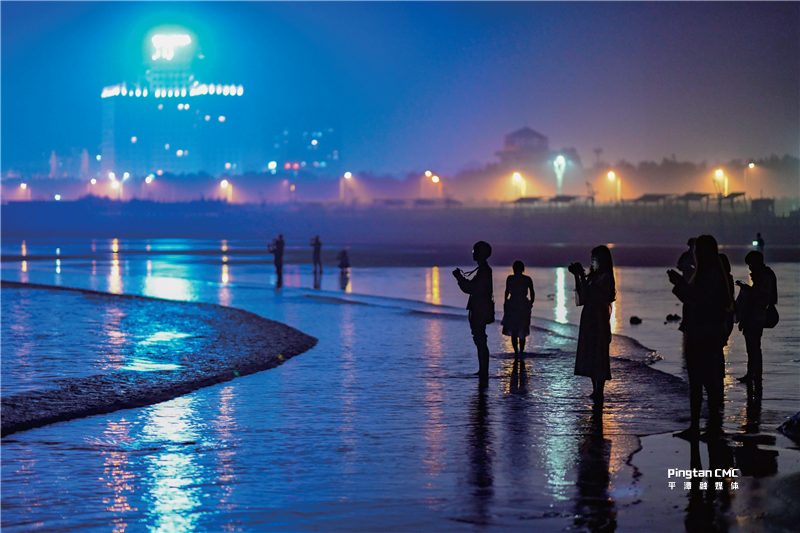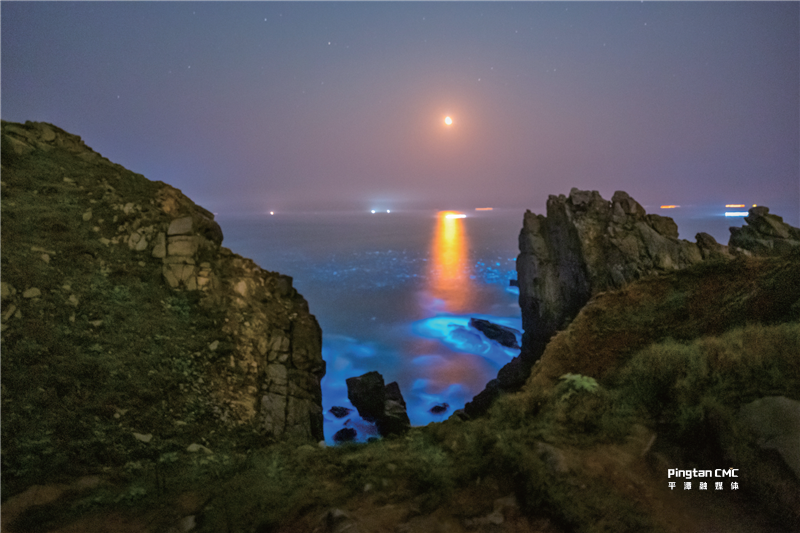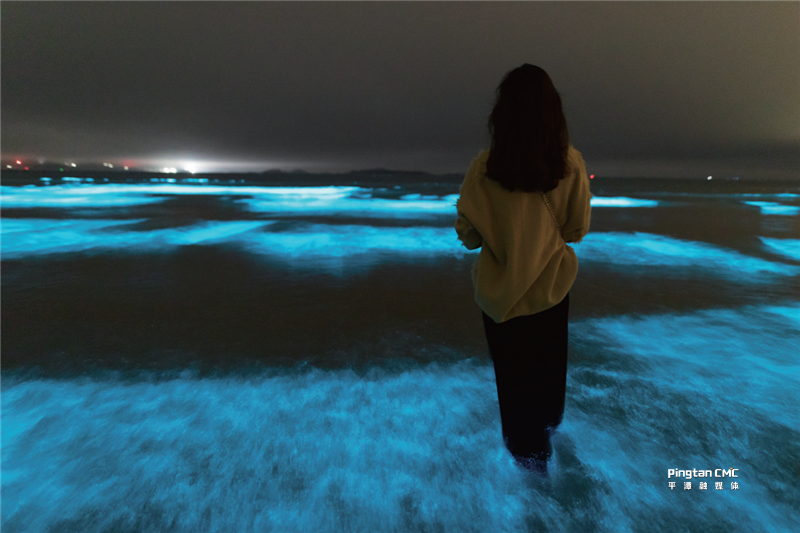BISU professor deciphers “Sea Sparkles”
en.ptnet.cn | Updated:2022-06-14 | Lin Kongbo, Stephanie"Dreamlike" "Aurora of the ocean"…you will find various descriptions of the bioluminescent phenomenon known as the "Blue Tears" or "Sea Sparkles" caused by phytoplankton called Noctiluca Scintillans. As the wondrous natural phenomenon became a hit on the Internet in recent years, tourists from all over the country flooded into Pingtan to witness and unravel the mystery occurring in the waters of Pingtan, the closest place on the mainland to the island of Taiwan as well as a rising international tourism island.
Cui Li, a professor specializing in modern ecological governance from the Beijing International Studies University (BISU) published an article centering around “Sea Sparkles” to mark the 14th World Oceans Day that takes place annually on June 8.

Tourists catch sight of “Sea Sparkle” at Longwangtou Bathing Beach of Pingtan.
However, beneath the beautiful facade, some controversies have arisen with its increased popularity. Cui quotes: "Sea Sparkles is a reflection of pollution" "Sightings of 'Sea Sparkles' are not good signs" "They are the tears left by invertebrates" and so on. To protect the sea better, we must understand the "Sea Sparkles."

“Sea Sparkles” against star trail [Photo by Yu Min]
"Sea Sparkles" is a kind of red tide. The appearance is not only affected by human activities but also a natural phenomenon. Despite so, it is also a natural cycle deemed the "flowering period" of the ocean. The red tide has existed since ancient times, holding traces of records in documents and literary works for over 2,000 years. For example, Pu Songling in the Qing Dynasty (1644-1912) documented strange luminescent seawater related to the red tides in his work titled Strange Tales of a Lonely Studio.

“Sea Sparkles” [Photo by Lin Xifeng]
“Blue Tears” are not real tears, but a poetic euphemism of the marine bioluminescence-like plankton and noctilucent algae aggregating in large numbers in the ocean. When disturbed by the waves, they will glow blue, just like the crystal blue tears shed by the sea, hence the name “Blue Tears.”

Tourists write Chinese character “平潭” on beach covered with “Sea Sparkles”
Marine algae play an important role in marine conservation. They are the oldest protophyte organisms on the earth, appearing as early as the Precambrian period. They are vital for the marine environment, marine animals, and the entire ecosystem of our planet, which takes on an irreplaceable role in purifying seawater, maintaining the balance of marine ecosystems, and sequestering carbon.
Marine algae are natural filters of seawater, which accelerate the self-purification ability of seawater by absorbing and assimilating dissolved organic substances in seawater, thereby improving water quality. In addition, large marine algae maintain the balance of dissolved oxygen and related elements in seawater by absorbing some pollutants in the ocean, hence delaying the eutrophication of sea areas.

Massive tourists drawn to “Sea Sparkles” scenic splendor
Although the Noctiluca algae responsible for the blue bioluminescence is non-toxic, any excess is just as bad. Too many algae can strain the ocean. The mucus they excrete will block the gills of the fish and prevent them from breathing, causing the fish to suffocate and threatening the survival of marine life. Even worse, these algae will depreciate oxygen-level in the water during decomposition, resulting in the death of fishes and other marine creatures and tipping the balance of the ecosystem.
Therefore, it is essential to properly use algae so that we can protect the entire marine ecosystem while appreciating the marvelous scene. The best protection is to utilize it sustainably.
The blooms are found mainly in Southeast China Sea like Fujian, Guangdong, and Zhejiang provinces. Among them, Pingtan Island, Fujian stands out with a high incidence of the phenomenon.
With the popularity of “Sea Sparkles,”Pingtan’s tourism has become increasingly prosperous. However, “Sea Sparkles” is only one of the attractions on the island. The winding coastline, premium soft beaches, staggered stone houses, and countless islets and reefs of Pingtan shine with their own brilliance.
Spotted a mistake or want to add something? All rights reserved. Do not reproduce our content without permission–you can contact us directly on our Facebook messenger or Twitter mailbox. Follow @pingtanchina (Facebook/Twitter)

 Fujian Public Security Registration Code: 35012802000119
Fujian Public Security Registration Code: 35012802000119